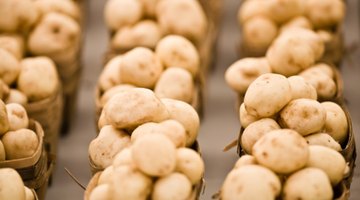How to Make & Grow a Mushroom Bed
Mushrooms are grown for a hobby and a food source. One major advantage to home mushroom cultivation is that you can decide which species of mushrooms you wish to grow, while most grocery stores limit their selections. You'll also know that your mushrooms are fresh and chemical-free.

Things You Will Need
- 33 lbs. wood chips
- 1 bale straw
- Water hose
- Mushroom spawn
- Shovel
Mushrooms are a healthy source of vitamins and protein. If you like to garden, the unique challenges of mushroom cultivation may inspire you to grow mushrooms.
Build the Mushroom Bed
-
Use a shovel to dig a hole that is between 4 to 5 inches deep and 32 feet long by 32 feet wide. This is the base of your mushroom bed. Make sure you dig the bed in a shady area of your yard and, if possible, within reach of your water hose.
-
Take half of the wood chips — approximately 16 lbs. — and spread them across the bottom of your hole. Your wood chips should be moist at this point. Keep them wet for 12 hours before you use them, and allow the excess water to drain off.
-
Place the mushroom spawn on the pile of wood chips. You can spawn the mushrooms yourself, but it takes a lot of preparation and a few thousand dollars' worth of equipment. It is best when you begin to cultivate your own mushrooms to buy mushroom spawn from a supplier.
-
Spread the spawn across the entire bed of wood chips. Make sure you have an even distribution of the mushroom spawn.
-
Add water to the straw. Once the straw is moist, layer it across the bed. The straw should be approximately 2 inches thick. This is a casing layer, and it helps to prevent your mushroom bed from drying out.
-
Distribute the rest of the wood chips across the mushroom bed. Water the bed, using a hose, as soon as you cover it with the wood chips.
Mushroom Growth
-
Water the bed every day.
-
Allow the mushroom spawn to spread out. The spawn has run through when the gray to white mycelium of the mushroom is visible throughout the bed.
-
Add more casing material, such as dung or peat moss, two weeks after you see the mycelium spread throughout the bed. This material promotes the mushroom growth.
-
Pick the mushrooms when the fruiting caps appear. The cap is the edible piece. Twist the cap off and pull up in one motion to successfully remove the mushroom. Brush it off to remove all of the casing material and other organic debris.
Tip
Keep in mind that certain species have different requirements. For example, some species of mushroom, such as annulata and aegerita, use a layer of soil on top of their mushroom bed after you place the final layer of wood chips. Do some research to know the specific requirements for your species of mushroom. Old mushroom bed material is good for other vegetable gardens.
Warning
Protect your mushrooms from frost. Wood chips also serve to keep the mushrooms sustainable when the temperature drops below 32 degrees Fahrenheit. In the fall, add approximately 2 inches of wood chips on top of your mushroom bed. Failure to do so could cause you to lose your mushroom harvest.
References
Tips
- Keep in mind that certain species have different requirements. For example, some species of mushroom, such as annulata and aegerita, use a layer of soil on top of their mushroom bed after you place the final layer of wood chips. Do some research to know the specific requirements for your species of mushroom.
- Old mushroom bed material is good for other vegetable gardens.
Warnings
- Protect your mushrooms from frost. Wood chips also serve to keep the mushrooms sustainable when the temperature drops below 32 degrees Fahrenheit. In the fall, add approximately 2 inches of wood chips on top of your mushroom bed. Failure to do so could cause you to lose your mushroom harvest.
Writer Bio
Todd Young has been writing professionally since 2010, with travel-oriented pieces and other works appearing on various websites. He attended the University of Kentucky and earned a Bachelor of Arts in political science and a Bachelor of Arts in history.
Photo Credits
- Jupiterimages/Photos.com/Getty Images
- Jupiterimages/Photos.com/Getty Images
More Articles



